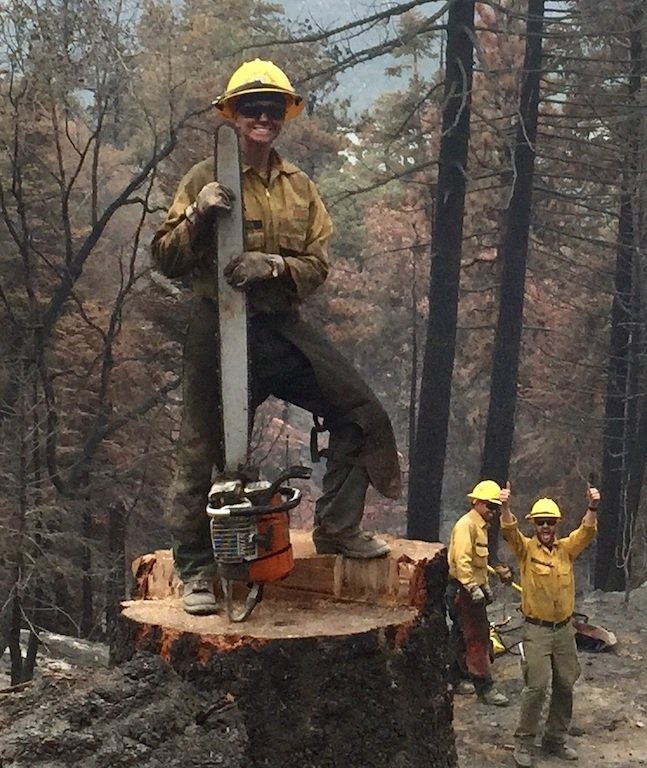
Screengrab from the YouTube video 2017 WFSTAR: Another Tool in the Box – National Rappel Program.
The Shoshone National Forest has 2.4 million acres that encompass Wyoming and Montana’s state line where meadows, rugged mountains, forests, and rivers are scattered across the landscape. The Yellowstone Timberland Reserve acquired it in 1891, making the Shoshone National Forest the first forest reserve in U.S. history. The turn of the 20th century saw an expansion of 150 reserve forest units that covered over 172 million acres.
In 1910, the “Big Blowup” involved forest fires across Idaho, Montana, and Washington, during which fire prevention and protection led to the development of many innovations. The decades that followed produced the emergence of U.S. Forest Service (USFS) personnel — from lookouts in towers to smokejumpers who parachute from airplanes and elite groups of firefighters who rappel out of helicopters in the middle of wildfires.

Canada’s Department of Lands and Forests (DLF) and the USFS inquired about the use of helicopters as early as 1943, but the realization of their multi-purpose capability came in June 1946 when a Bell 47 helicopter conducted geophysics surveys and fire reconnaissance in Canada. In the summer of that same year, Alaska’s Fire Service ran its own tests. By 1947, Angeles National Forest in Los Angeles, California — one of the driest and most fire-prone areas in the U.S. — contracted the first helicopters to fight forest fires.
The inception of the USFS Helitack — “helicopter initial attack of wildfires” — crews came during the 1957 fire season and have been integral in wildland fire suppression ever since. Black Hills Helitack was one of the earliest crews and operates their helibase out of Custer, South Dakota, where their eight members respond to an average of 50 forest fires between June and September. With eyes in the sky that feature a 50- to 70-mile attack range, the pilots could track fire progression, wind changes, and give accurate perspective from an aerial view to those on the ground. When the helicopters landed and dropped off the crew members in the back on a fire, they offloaded all their gear and cargo and went to work. The crews built firelines using Pulaski tools and felled trees with chainsaws.

Sometimes the crews camp overnight, so there’s a purpose for every pound of gear they carry in their packs — which is sometimes as heavy as 120 pounds. When the job is done, they hike to a pickup point and the helicopters fly them back to base. For fires that are in the backcountry and inaccessible by landing, rappelling equipment is used. The Redmond Smokejumpers first explored a rappelling program in 1972.
“The jumpers took what they did and adapted it to the helicopter,” said Ken Ross, the Helicopter Program Manager for Pacific Northwest Region. Rappellers today can repel 250 feet from light or medium helicopters and land precisely between tall trees.
The incredible ingenuity and safety record of rappel-capable helitack crews sprouted 45 rappel-capable helitack bases across the country. Soon after, other nations including Canada, Australia, and Russia adopted and developed their own rappelling programs — Russia having the largest in the world with more than 4,000 rappellers. The USFS is continuously developing their capabilities, and in 2015 they introduced the short-haul program where rappel-capable helitack crews inserted into austere terrain to provide life-saving aid. The USFS previously contracted these operations to military and civilian practitioners, but their first medevac occurred in June 2018 on the Trail Mountain Fire on the Manti-La Sal National Forest in Utah.

Matt Fratus is a history staff writer for Coffee or Die. He prides himself on uncovering the most fascinating tales of history by sharing them through any means of engaging storytelling. He writes for his micro-blog @LateNightHistory on Instagram, where he shares the story behind the image. He is also the host of the Late Night History podcast. When not writing about history, Matt enjoys volunteering for One More Wave and rooting for Boston sports teams.
BRCC and Bad Moon Print Press team up for an exclusive, limited-edition T-shirt design!
BRCC partners with Team Room Design for an exclusive T-shirt release!
Thirty Seconds Out has partnered with BRCC for an exclusive shirt design invoking the God of Winter.
Lucas O'Hara of Grizzly Forge has teamed up with BRCC for a badass, exclusive Shirt Club T-shirt design featuring his most popular knife and tiomahawk.
Coffee or Die sits down with one of the graphic designers behind Black Rifle Coffee's signature look and vibe.
Biden will award the Medal of Honor to a Vietnam War Army helicopter pilot who risked his life to save a reconnaissance team from almost certain death.
Ever wonder how much Jack Mandaville would f*ck sh*t up if he went back in time? The American Revolution didn't even see him coming.
A nearly 200-year-old West Point time capsule that at first appeared to yield little more than dust contains hidden treasure, the US Military Academy said.












